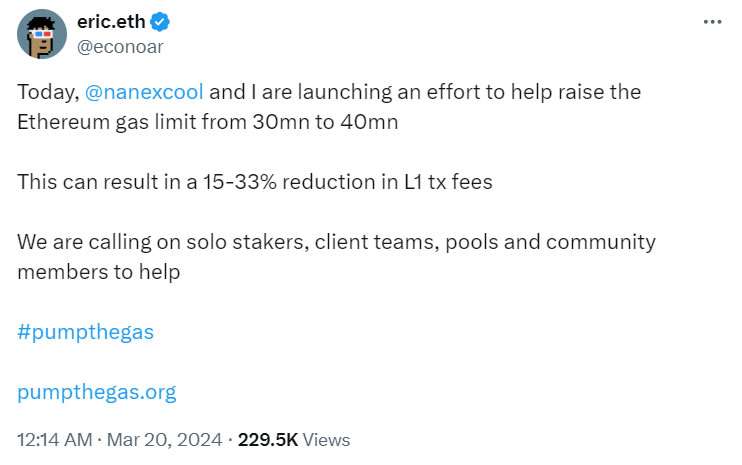
Ethereum Developers Launch ‘Gas Boost’ to Raise Limit
Ethereum developers are pushing to increase the gas limit from 30 million to 40 million, aiming to reduce transaction costs on layer 1.
Ethereum developers have begun a new attempt to boost the long-static gas limit of the blockchain network. They argue that this adjustment can aid in scaling Ethereum.
Ethereum Developers To Raise Gas Limit
A new website named “Pump the Gas” was introduced on March 20 by core Ethereum developers Eric Connor and Mariano Conti, who had previously served as the heads of intelligent contracts at MakerDAO.

The purpose of the website is to increase the limit of Ethereum gas from 30 million to 40 million, which, according to Ethereum developers, will decrease transaction costs on layer 1. In a post that Connor made on X on March 19, he stated,
“This can result in a 15% to 33% reduction in layer-1 transaction fees.” He said, “We are calling on solo stakers, client teams, pools, and community members to help.” Several Ethereum Developers, stakers, and DeFi investors on X have already begun to support the #pumpthegas hashtag.
Additionally, Conti observed that on March 20th, a Rocket Pool validator requested a block with a gasoline maximum of 40 million. Over the past few months, there have been a growing number of people advocating for an increase in the gas limit for Ethereum.
In January, Vitalik Buterin, a co-founder of Ethereum, suggested raising the gas limit from 30 million, which has been in place since August 2021, to 40 million.

Jesse Pollak, a contributor to Base, responded by stating that he was “strongly in support” of increasing the gas limit for Ethereum to either 40 or 45 million. He continued by saying, “We have the network headroom, and working together will be beneficial for all parties.”
The term “Ethereum gas limit” describes the maximum amount of gas required to execute intelligent contracts or blockchain transactions within each block. To carry out a transaction or execute a smart contract on the network, a fee known as gas is required.
The website mentioned that every operation has a predetermined gas cost and contracts have a gas limit they cannot exceed during execution.
This prevents malicious contracts from consuming an excessive amount of resources or overloading the network with infinite loops. The statement noted that increasing the gas block limit by 33 percent will allow Layer 1 Ethereum to process 33 percent more transaction load in a single day.
Additionally, the Dencun update with EIP-4844 developed data blobs, which significantly reduce layer-2 transaction fees without affecting layer-1 prices. The report said that “a combination of blobs and gas limit increases can help scale both L1 and L2 Ethereum simultaneously.”

On the other hand, not everyone favors this modification to the network. In a post on X, venture capitalist and Ethereum advocate Evan Van Ness stated, “I’m not in favor of raising the mainnet gas limit *today* as EIP-4844 just raised the block size.”
Van Ness is a supporting member of the Ethereum community. Marius van der Wijden, an Ethereum Developer, voiced his concern about the proposed boost earlier this year, noting that it would increase the size of the blockchain state, comprised of account balances and data about smart contracts.
He stated at the time that size was not the problem, and then he said that “accessing and modifying it will become slower and slower.” He then went on to say that there are “no concrete solutions yet for state growth.”
Other potential drawbacks of increasing the gas limit include the possibility of more significant network spam and attacks, as well as increased pressures on the hardware infrastructure.





